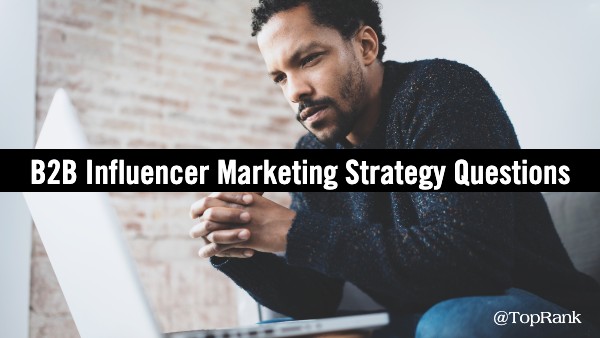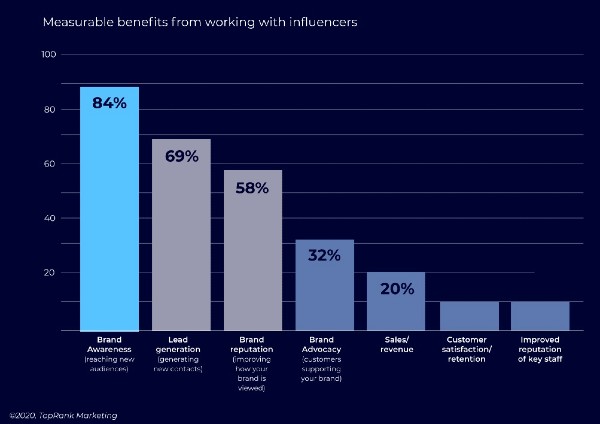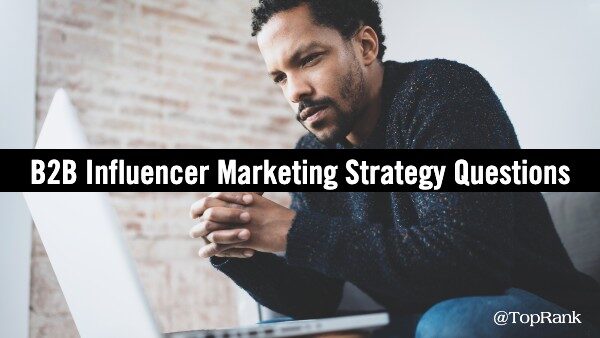
It’s no mystery that we’re big fans of influencer marketing where B2B brands engage with industry experts and key opinion leaders to drive conversations, consideration and conversions.
Marketing leaders at B2B companies large and small are realizing how much influence can play a role in virtually every customer communication. As 2021 picks up steam, the practice of influencer marketing presents unique opportunities to optimize digitally transformed B2B marketing.
That said, while the role of influence can be universally present in content and communications, the approach that will work for any given B2B brand is by no means cookie cutter. Influencer engagement is not simply an advertising buy or some kind of programmatic marketing tactic. It’s simultaneously dynamic and open to certain kinds of optimization and scale through process, operations and expertise.
Before embarking on a pilot, campaigns or an evolved always-on influencer program, it’s important for B2B marketers to answer a few key questions to make sure the rationale is sound, the approach has merit and the expectations line up with resources and goals.
At TopRank Marketing we’ve helped numerous B2B brands run their very first influencer marketing pilot projects and campaigns. Our work with B2B brands like LinkedIn, SAP and Dell over the past 9 years has taught us that there are many key questions to be answered in order to ensure
- Influencer marketing makes sense for a particular B2B brand
- That a specific approach matches goals, resources and expectations
- The tactics of identifying and engaging influencers are appropriate to content formats, channels and audience
- The program reaches expected KPIs and drives value both for the business and influencers
- Early efforts set the stage for future success
To help B2B brands thinking about launching an influencer marketing initiative, here are 5 of the most important questions to answer:
1. What is a B2B influencer for our brand? Our customers?
Success with B2B influence means avoiding falling into the popularity trap and thinking that all influencers must have a massive following.
An influencer in the B2B world is someone that has domain expertise, is recognized by peers for that expertise, creates content or communicates about that expertise, and has attracted the attention and trust of a network.
B2B influencers are also often called subject matter experts, key opinion leaders, or simply experts about a certain topic. This differs than in B2C where popularity and being able to publish influencer-created content on their own channels to a large audience reigns supreme. B2C influencers are most often very self aware of their actual or aspirational influence and bring content creation, personality, persuasion and publishing skills to the situation.
For B2B influencers, the idea of being an “influencer” may not be a priority, so B2B brands need to find ways to activate and engage them in ways that might be new to the influencer. Fortunately, there are best practices around how to nurture both external and internal subject matter experts to collaborate with marketing in ways that can drive authentic conversations amongst a desirable audience.
There are several key characteristics to look for in a B2B influencer: Proficiency, Popularity, Personality, Publisher, Promoter. For a deeper dive into what top B2B influencers look and sound like, check out Season 3 of Break Free B2B in progress.
Understanding that everyone has some degree of influence is as important for a new influencer marketing effort as is understanding that B2B brands need to be clear about what topics they want to be influential about. Finding B2B influencers for a specific brand means identifying the topics that matter to customers in the context of the B2B brand’s marketing narrative. Topics of importance to customers relative to the B2B brand’s key messages, products and solutions helps us understand whether a particular influencer has the attention and ability to influence their network. We do that by using software that helps evaluate a given influencer’s audience for topical relevance, resonance and reach.
There are different types of influencers to engage according to the type of influencer marketing project being implemented. Some programs might call for celebrity level “brandividuals“, others might focus more on those with industry analyst level expertise, or niche influencers that have deep product expertise and specific media creation skills that align with the content preferences of a B2B brand’s audience. At the same time, some influencers might already be fans of your B2B brand and others might be strong advocates of ideas that align with your brand but not be advocates yet.
The opportunity in identifying what a B2B influencer looks like for your brand starts with understanding the topics of influence that matter to your customers and that are most relevant to your solutions. That topic understanding can be extended to the creation of an ideal influencer profile and the matching of influencer types to the expectations and experiences created for customers.
To answer, “Where can I find B2B influencers?” marketers need to look beyond their own opinions and experiences and towards data. Influencers that create evidence of their expertise through digital content can be identified with influencer marketing software or social media software. However, keep in mind that many B2B influencers do not focus solely on social media to proclaim their expertise and more in-depth research into industry associations, special interest groups, events, publications, email newsletters and emerging formats like Clubhouse should be conducted.
2. What can we expect to achieve working with influencers?
Virtually all B2B brand communications with customers is a consideration for including 3rd party expertise for credibility and help with distribution.
Fundamentally, influencers can create value for B2B brands in a few different ways:
- Add credibility to brand content
- Help brand content reach new audiences through promotion
- Provide B2B brands with advisory services
- Perform as a brand advocate through ongoing content engagement
- Help create content for thought leadership and demand gen purposes
- Add signals of credibility to content for SEO
- Facilitate content distribution and brand social network growth
- Provide expertise for earned media, events and marketing content
In our research as reported in the State of B2B Influencer Marketing Report, we found that the measurable benefits for B2B brands to work with influencers included:

What’s important for B2B marketers to understand when it comes to what’s possible with influencers is that we’re talking about partnering with people, not simply using them to some brand end. Rather than thinking of influencers only as a means to an end or a tool for content creation and distribution, it is more valuable for all when B2B brands think of influencers as partners they can work with to achieve mutual goals. That partnership can turn to authentic and enthusiastic brand advocacy more quickly than a transactional approach.
For more specific ideas, check out this list of 25 B2B influencer marketing campaign and engagement ideas.
3. What are some good influencer engagement models?
Many early stage influencer programs start with micro-activations as part of a nurturing effort to develop relationships between brand and influencer. In many cases, an agency is tasked with creating these connections because they have unique expertise at influencer outreach and/or may already have the desired influencers in the agency network.
The right engagement model really depends on the approach.
For a pilot influencer content marketing campaign designed to create a business case for potential expansion of an influencer marketing program that has some lead time, it might be best to develop quick rapport with influencers by recognizing their expertise publicly. Then follow up and invite them to collaborate on small asks with great exposure. Through these early micro-activations, the right influencers can be sorted for a larger contribution to the pilot content project. See this case study on how LinkedIn has taken a relationship building approach to their always-on influence program working with sales and marketing influencers.
Alternatively, if there is not much lead time for organic relationship building with a pilot, then professional influencers can be engaged for their services to contribute to the pilot. The cost and perceived authenticity of content disclaimed as sponsored may be worth it to get a pilot out quickly. Or some combination of organic relationship building and paid influencer engagement might be most appropriate.
Understanding the right engagement model can be helped in part by reviewing solid B2B influencer marketing examples and case studies to understand what goes into successful B2B influencer marketing campaigns.
Also, it’s important to understand that working with influencers for an industrial or manufacturing business might be a bit different than how influencer marketing for tech companies might work. The topics of interest to customers and of most relevance to influencers and the brand will help identify the right influencer program approach, influencer identification and engagement.
Many pilots lead to sequences of campaigns which may engage the same influencers or different influencers each time. Lack of engagement in between campaigns will make securing influencers more difficult. B2B brands that are more mature in their influencer marketing efforts engage in always-on influencer programs. In fact, the State of B2B Influencer Marketing Report found that 12X more B2B marketers using an always-on approach were very successful with their influencer marketing compared to those marketers that implementing periodic campaigns.
Working with a small group of influencers can be a great place to start, but that small group should be backed by a much larger list of researched candidate influencers. As relationships develop through the course of different collaborations, B2B marketers will refine and find the right influencers. A VIP group of influencers might be created as Adobe has with its 60+ Adobe Insiders being activated at individual, small group or large group levels depending on the situation.
4. How does “dark influence” fit in our mix?
Understanding the channels where customers are spending time discovering, consuming and engaging with content is central to identifying sources of influence. But not all B2B influencers are social media rockstars. To understand where and how the right experts are influential to the customers of a B2B brand, thoughtful research must be conducted to identify customer preferences for content and people that they trust, subscribe to and are influenced by.
In some cases, the social media connection to B2B influence is indirect. While many business people are doing business during their 9-5, increasing numbers of business people are following industry experts on social channels. They access those channels before and after work as well as periodically during the day.
For those influencers and customers that are not engaging via social media, content discovery, consumption and engagement preferences research will reveal the email newsletters, publications, associations, events, groups and even search terms they use to connect. These non-social media channels are opportunities for influence as well. B2B marketers need to do the research to map these sources of engagement and identify influencers that might be good partners for those channels.
Another consideration is the role that LinkedIn plays in terms of influencer performance tracking. Since the vast majority of LinkedIn is not public nor do they provide easy access via API, the social data cannot be crawled in the way that Twitter, some Facebook content and other social networks are. Influencer engagement on LinkedIn may require use of tools made available from LinkedIn like Sales Navigator. Here are some ideas on how to engage influencers on the LinkedIn platform.
Working within the world of dark social for influencer marketing means connecting with influencers that use these channels and engaging them on collaborations where they exert influence.
5. What are the most important operational considerations for a B2B influencer marketing program?
For large enterprise organizations, there is often a debate about how much influencer marketing should be centralized in the organization vs. with business units, divisions and regions. When influencer marketing is new to an organization, there is centralization and programs are dictated as such. Some influencers may be universally relevant across and organization but within each market where a B2B brand operates, there will likely be more niche influencers specific to those markets.
How an influencer marketing program is defined will often include both the universal truths that are relevant for the brand overall and specific programs with unique goals, topics and measures of success.
Some of the most important operational considerations for an influencer marketing program include:
- What department owns influencer marketing?
- What processes will be used to to perform the functions of influencer marketing to ensure consistency and quality?
- What software will be used to identify, engage, communicate with and measure influencers?
- What budgets, staffing and external resources will be needed short and long term?
Beyond measures of success, software and ownership with the B2B brand of an influencer program is how to work with a specialist B2B influencer marketing agency to help develop strategy and planning, influencer identification and recruitment, collaboration and creation of influencer / brand content assets. In the State of B2B Influencer Marketing Report that surveyed hundreds of B2B marketers, the top tasks handled by agencies included:
- Identifying influencers 79%
- Managing influencer relationships 76%
- Developing the strategy 71%
- Measuring effectiveness 66%
- Integrating with other marketing efforts 63%
- Implementing campaigns 60%
- Managing influencer marketing technology 44%
While there are many B2B marketing resources out there to help brands with everything from research and strategy to planning, implementation and measurement, there are simply not that many B2B influencer marketing agencies that have:
- Established influencer marketing strategy frameworks based on years of experience
- Extensive relationships with a network of B2B influencers in various verticals
- Tried and true tactics for accelerating B2B brand and influencer relationships
- Content creation and repurposing capabilities that are unique to influencer collaborations
- Influencer marketing measurement and reporting expertise
- Savvy on how to maintain ongoing influencer relationships in between campaigns
The good news is that the number of B2B influencer marketing agencies with legitimate skills and experience is growing as awareness grows around the role of influence across the entire customer lifecycle for business customers.
There are certainly more questions than these to be considered as well as variations on the questions that have been listed in order for B2B marketers to gain confidence that their particular approach to an influencer marketing effort creates the expected value for all involved. In many cases, marketing missteps can be avoided by ensuring the fundamentals are solid and that’s what this list of questions is meant to do – cover the bases that are essential for a thoughtful, meaningful and productive influencer marketing effort.
Influencer marketing is a relationship focused business and that means it’s dynamic and there are no silver bullet answers.
Remember, influencer marketing is a relationship focused business and that means it’s dynamic and there are no silver bullet answers. B2B brands that stumble blindly into an influencer engagement effort may experience disappointing results without the “been there, done that” and “we do this every. single. day.” type of expertise that is rare, but available through specialist agencies and consultants.



